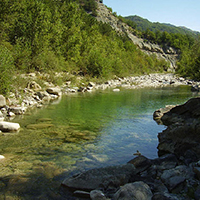Pioneer annual vegetation of gravel-bed rivers: first insights on environmental drivers from three Apennine streams

Submitted: 13 August 2021
Accepted: 11 October 2021
Published: 12 October 2021
Accepted: 11 October 2021
Abstract Views: 611
PDF: 175
HTML: 14
HTML: 14
Publisher's note
All claims expressed in this article are solely those of the authors and do not necessarily represent those of their affiliated organizations, or those of the publisher, the editors and the reviewers. Any product that may be evaluated in this article or claim that may be made by its manufacturer is not guaranteed or endorsed by the publisher.
All claims expressed in this article are solely those of the authors and do not necessarily represent those of their affiliated organizations, or those of the publisher, the editors and the reviewers. Any product that may be evaluated in this article or claim that may be made by its manufacturer is not guaranteed or endorsed by the publisher.
Similar Articles
- Rafał Chmara, Józef Szmeja, Krzysztof Banaś, The relationships between structural and functional diversity within and among macrophyte communities in lakes , Journal of Limnology: Vol. 77 No. 1 (2018)
- Robin J. Smith, Dayou Zhai, Suktonthip Savatenalinton, Takahiro Kamiya, Na Yu, A review of rice field ostracods (Crustacea) with a checklist of species , Journal of Limnology: Vol. 77 No. 1 (2018)
- Claude Lang, Phosphorus decreases in Lake Geneva but climate warming hampers the recovery of pristine oligochaete communities whereas chironomids are less affected , Journal of Limnology: Vol. 75 No. 2 (2016)
- Francisco Diogo R. Sousa, Alexandre V. Palaoro, Lourdes M.A. Elmoor-Loureiro, Alexey A. Kotov, Predicting the invasive potential of the cladoceran Daphnia lumholtzi Sars, 1885 (Crustacea: Cladocera: Daphniidae) in the Neotropics: are generalists threatened and relicts protected by their life-history traits? , Journal of Limnology: Vol. 76 No. 2 (2017)
- Jong-Yun Choi, Kwang-Seuk Jeong, Geung-Hwan La, Seong-Ki Kim, Gea-Jae Joo, Sustainment of epiphytic microinvertebrate assemblage in relation with different aquatic plant microhabitats in freshwater wetlands (South Korea) , Journal of Limnology: Vol. 73 No. 1 (2014)
- Vanessa Pendino, Luca Vecchioni, Fabio Stoch, Federico Marrone, Checklist and distribution of the groundwater crustacean fauna from Sicily, Italy , Journal of Limnology: Vol. 83 (2024)
- Sanna T. Korkonen, Antti E.K. Ojala, Emilia Kosonen, Jan Weckström, Seasonality of chrysophyte cyst and diatom assemblages in varved Lake Nautajärvi – implications for palaeolimnological studies , Journal of Limnology: Vol. 76 No. 2 (2017)
- Thaisa S. Michelan, Márcio J. Silveira, Danielle K. Petsch, Gisele D. Pinha, Sidinei M. Thomaz, The invasive aquatic macrophyte Hydrilla verticillata facilitates the establishment of the invasive mussel Limnoperna fortunei in Neotropical reservoirs , Journal of Limnology: Vol. 73 No. 3 (2014)
- Bárbara Becker, Bárbara de Oliveira Sanches Galhardo, Diego Rodrigues Macedo, Robert M. Hughes, Marcos Callisto, Gilmar B. Santos, Influence of limnological zones on the spatial distribution of fish assemblages in three Brazilian reservoirs , Journal of Limnology: Vol. 75 No. 1 (2016)
- Giuseppe Alfonso, Fabio Stoch, Federico Marrone, An annotated checklist and bibliography of the Diaptomidae (Copepoda, Calanoida) of Italy, Corsica, and the Maltese islands , Journal of Limnology: Vol. 80 No. 3 (2021): Celebratory Issue - 80th Anniversary of the Journal of Limnology
You may also start an advanced similarity search for this article.

 https://doi.org/10.4081/jlimnol.2021.2052
https://doi.org/10.4081/jlimnol.2021.2052






